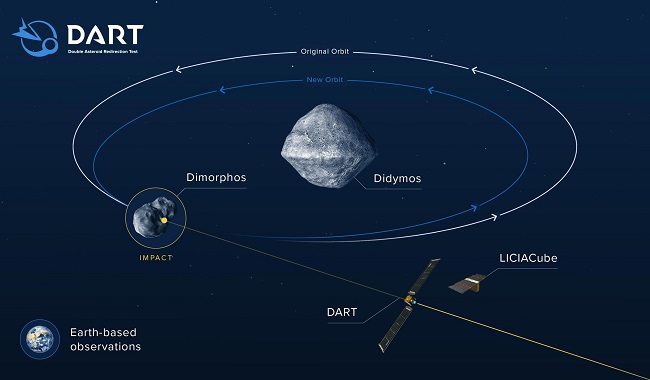
Can we change the course of an asteroid by hitting it? DART mission will find out
Is it possible to change the course of an asteroid by crashing into it with an aircraft? A new NASA mission will give us the answer to this question: today, the DART mission spacecraft will crash into the asteroid Dimorph at a speed of 24,000 km/h.
The apparatus, the size of a bus was launched from Earth in November 2021, and its main purpose is not so much to change the course of the asteroid, but to find out whether our planet can be protected from dangerous asteroids if you hit them with a flying machine.
The Hubble and James Webb space telescopes will follow the collision, and for the latter it will not be an easy task, because it was not originally designed for this purpose. As for the Hubble, because of its location, it will be able to show what happened only 15 minutes after the collision of the asteroid and the aircraft.
The LICIACube, a shoebox-sized mini-spacecraft developed by the Italian Space Agency and the aerospace engineering company Argotec, will also have to record the collision. It was first attached to an aircraft, but recently separated from it and now travels on its own to witness a collision at a safe distance of 55 km. It may take LICIACube may take several weeks to send all the images received back to the Earth.

Dimorph is 11 million kilometers from Earth, and although it is considered a relatively close asteroid to us, it does not pose a threat to the Earth right now. Dimorph is a satellite of a larger 780-meter asteroid called Didim, and this fact will facilitate the measurement of the result of the collision: scientists will be able to assess whether the impact will change the trajectory of Dimorph around Didim.
The asteroid Dimorph is actually quite small: its diameter is only about 163 meters, and its collision with the Earth, although it will pose a significant threat, but it will not be a disaster of planetary scale.
The aircraft that will crash into it is also small – only about 1.2 meters across. Despite all this, DART is a unique mission that can give a lot of useful information to scientists.
- Related News
- Perseverance finds rock on Mars with signs of life on Earth (photo)
- On 25th anniversary of Chandra telescope, NASA released 25 photos previously unseen by the public
- Rare intermediate-mass black hole has been discovered at the center of our galaxy
- Stone "snowman" and pure sulfur crystals on Mars։ Remarkable discoveries by Perseverance and Curiosity
- When will humanity settle on Mars? Interview with Gernot Grömer
- TESS telescope discovers super-hot exoplanet the size of Neptune
- Most read
month
week
day
- Buyers massively complain about Samsung's Galaxy Buds 3 and Buds 3 Pro headphone, even finding hair in the box 822
- With today's mortgage interest rates, banks simply cannot sell products in 2025: Interview with Vardan Marutyan 813
- Ants and bees 'taught' tiny drones to navigate without GPS, beacons or lidars 677
- Samsung will release Galaxy Tab S10+ and Ultra tablets and Galaxy Z Fold 6 Slim and Galaxy w25 smartphones in October 642
- Mass production of iPhone SE 4 will begin this October, with sales starting in 2025 603
- Insider unveils specs of all smartphones of iPhone 17 series, including the 17 Slim 600
- Telegram's monthly active audience reaches 950 million 586
- What dangers can feature phones from unknown manufacturers conceal? 559
- For the first time in history, iPhone will get a Samsung camera 556
- What are the problems in the construction industry? Interview with Vardan Marutyan 552
- Archive
